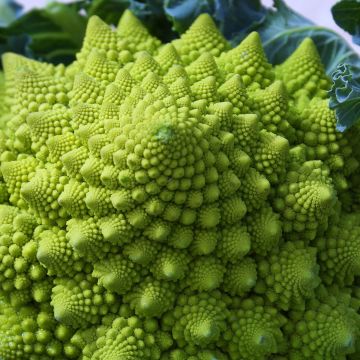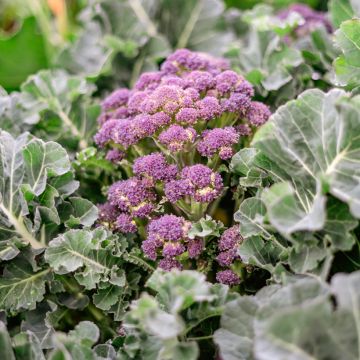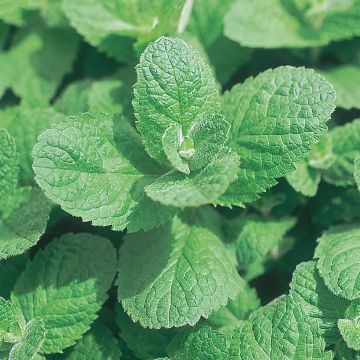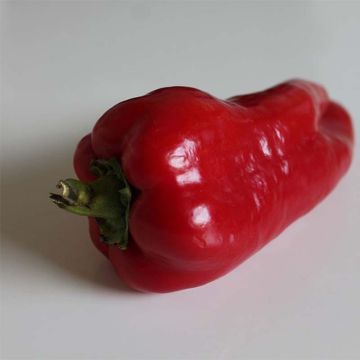

Organic Broccoli Santee Purple plugs - Brassica oleracea cymosa
Organic Broccoli Santee Purple plugs - Brassica oleracea cymosa
Brassica oleracea botrytis cymosa italica Santee Purple
Purple Sprouting Broccoli
Beautiful organic plant that will undoubtedly delight us! It is mentioned that it is Perennial!? Yet cabbages are more often annuals or maybe persist for 1 or 2 more years at best, right?! Thank you for offering such unique vegetables, which also look great surrounded by beautiful flowering plants ????????????????
Alain, 27/03/2023
Special offer!
Receive a €20 voucher for any order over €90 (excluding delivery costs, credit notes, and plastic-free options)!
1- Add your favorite plants to your cart.
2- Once you have reached €90, confirm your order (you can even choose the delivery date!).
3- As soon as your order is shipped, you will receive an email containing your voucher code, valid for 3 months (90 days).
Your voucher is unique and can only be used once, for any order with a minimum value of €20, excluding delivery costs.
Can be combined with other current offers, non-divisible and non-refundable.
Why not try an alternative variety in stock?
View all →This plant carries a 6 months recovery warranty
More information
We guarantee the quality of our plants for a full growing cycle, and will replace at our expense any plant that fails to recover under normal climatic and planting conditions.
Description
The Organic Santee Purple Sprouting Broccoli is a variety of sprouting broccoli that produces a main stem with a central head and numerous secondary stems in the axils of all its leaves, each terminated by a small fleshy floral bud whose buttons remain visible. It is these young shoots of purple colour of this Santee Purple variety, with a very delicate flavour, that are eaten in the same way as asparagus. The plug plants of this variety can be planted from April to September. The young stems are harvested as needed.
Broccoli Sprouting is a vegetable whose floral stems are consumed before the flowers bloom. It has stems and floral heads that are most often green, but sometimes purplish or white. Broccoli belongs to the large family of Brassicaceae (formerly Cruciferae), like other Cabbages: Cauliflower, Brussels Sprouts, Smooth-leafed Cabbage (or White Cabbage), Savoy Cabbage, Green Cabbage or Curly Cabbage, Kohlrabi, Chinese Cabbage... The Sprouting Broccoli has the Latin name Brassica oleracea italica botrytis cymosa. This Santee Purple variety is prolific, the more its stems are cut, the more it produces new ones.
Like almost all cabbages (except Brussels Sprouts), Sprouting Broccoli is a demanding vegetable. It requires excellent base fertilisation and regular moisture. Sprouting broccoli is much more resistant to diseases than other cabbages and cauliflower.
Harvest: Sprouting Broccoli is harvested at different times of the year, as long as it produces new shoots. Generally in spring and early summer, but also in winter. In winter, the central heads can be harvested. This results in the formation of smaller but numerous secondary stems and flowers. When cut, they are quickly replaced by other floral stems. It is essential to harvest the heads as soon as they start to develop, otherwise they quickly flower (open).
In terms of cooking: sprouting broccoli is a low-calorie plant known for its nutritional qualities and its content of vitamins C and A. It is steamed or sautéed, and consumed as a side dish with meat and fish plants.
Storage: It is best to consume Sprouting Broccoli quickly after harvest, as it does not keep well, only a few days in the refrigerator. You can also freeze it after blanching it for 3 minutes in salted boiling water.
Gardener's tip: In recent years, the Cabbage Midge (Contarinia nasturtii), a small winged piercing and sucking fly, has been causing havoc on Broccoli Sprouts. We recommend opting for prevention by installing an insect-proof net tightly on market garden hoops throughout the flight period, from mid-May to mid-July. These nets are easy to set up and reusable to protect, for example, your carrot and leek crops.
Harvest
Plant habit
Foliage
Other Broccoli
View all →Planting and care
Purple Sprouting Broccoli with shoots is a greedy vegetable that requires well-fertilised soil, rich in nitrogen and potassium. It is advisable to make a generous compost addition (about 3/4 kg per m2) in autumn, by scratching to a depth of 5 cm (2in), after having loosened the soil as for any vegetable crop.
Planting: The plug plants of this variety are planted from April to September for a harvest from June to November. In mild climates, the harvest can start as early as January-February. Each pruning of the young shoots results in the formation of new flower stems.
First, let the plug plants grow by transplanting them into trays or buckets with a diameter of 8 to 13 cm (3 to 5in), filled with potting soil. Place them in a warm and bright place. Water regularly.
For planting in open ground, choose a sunny location (or partial shade if your summers are very hot). Space the plants 65 cm (26in) apart in all directions. Soak the root ball in water for a few moments before planting. Dig a hole, place the plant and cover with fine soil. Water thoroughly.
At the beginning of the cultivation, it is advisable to hill up the soil around the Cabbages to allow for better anchoring in the soil and better root development.
Then, to limit watering, we recommend mulching the soil with thin successive layers of grass clippings, preferably mixed with dead leaves.
During cultivation, water moderately but regularly.
Purple Sprouting Broccoli is less susceptible to diseases such as Clubroot and pests (Cabbage White, Cabbage Fly, Flea Beetle, Cabbage Midge, etc.). However, it is preferable, for this crop, to pay attention to crop rotations.
It is beneficial to associate it with many vegetables such as tomato, lettuce, etc. However, avoid planting it near other Brassicas as well as zucchini, fennel, corn salad, leek, and strawberry.
Cultivation
Care
Intended location
Planting & care advice
-
, onOrder confirmed
Reply from on Promesse de fleurs
Similar products
Haven't found what you were looking for?
Hardiness is the lowest winter temperature a plant can endure without suffering serious damage or even dying. However, hardiness is affected by location (a sheltered area, such as a patio), protection (winter cover) and soil type (hardiness is improved by well-drained soil).

Photo Sharing Terms & Conditions
In order to encourage gardeners to interact and share their experiences, Promesse de fleurs offers various media enabling content to be uploaded onto its Site - in particular via the ‘Photo sharing’ module.
The User agrees to refrain from:
- Posting any content that is illegal, prejudicial, insulting, racist, inciteful to hatred, revisionist, contrary to public decency, that infringes on privacy or on the privacy rights of third parties, in particular the publicity rights of persons and goods, intellectual property rights, or the right to privacy.
- Submitting content on behalf of a third party;
- Impersonate the identity of a third party and/or publish any personal information about a third party;
In general, the User undertakes to refrain from any unethical behaviour.
All Content (in particular text, comments, files, images, photos, videos, creative works, etc.), which may be subject to property or intellectual property rights, image or other private rights, shall remain the property of the User, subject to the limited rights granted by the terms of the licence granted by Promesse de fleurs as stated below. Users are at liberty to publish or not to publish such Content on the Site, notably via the ‘Photo Sharing’ facility, and accept that this Content shall be made public and freely accessible, notably on the Internet.
Users further acknowledge, undertake to have ,and guarantee that they hold all necessary rights and permissions to publish such material on the Site, in particular with regard to the legislation in force pertaining to any privacy, property, intellectual property, image, or contractual rights, or rights of any other nature. By publishing such Content on the Site, Users acknowledge accepting full liability as publishers of the Content within the meaning of the law, and grant Promesse de fleurs, free of charge, an inclusive, worldwide licence for the said Content for the entire duration of its publication, including all reproduction, representation, up/downloading, displaying, performing, transmission, and storage rights.
Users also grant permission for their name to be linked to the Content and accept that this link may not always be made available.
By engaging in posting material, Users consent to their Content becoming automatically accessible on the Internet, in particular on other sites and/or blogs and/or web pages of the Promesse de fleurs site, including in particular social pages and the Promesse de fleurs catalogue.
Users may secure the removal of entrusted content free of charge by issuing a simple request via our contact form.
The flowering period indicated on our website applies to countries and regions located in USDA zone 8 (France, the United Kingdom, Ireland, the Netherlands, etc.)
It will vary according to where you live:
- In zones 9 to 10 (Italy, Spain, Greece, etc.), flowering will occur about 2 to 4 weeks earlier.
- In zones 6 to 7 (Germany, Poland, Slovenia, and lower mountainous regions), flowering will be delayed by 2 to 3 weeks.
- In zone 5 (Central Europe, Scandinavia), blooming will be delayed by 3 to 5 weeks.
In temperate climates, pruning of spring-flowering shrubs (forsythia, spireas, etc.) should be done just after flowering.
Pruning of summer-flowering shrubs (Indian Lilac, Perovskia, etc.) can be done in winter or spring.
In cold regions as well as with frost-sensitive plants, avoid pruning too early when severe frosts may still occur.
The planting period indicated on our website applies to countries and regions located in USDA zone 8 (France, United Kingdom, Ireland, Netherlands).
It will vary according to where you live:
- In Mediterranean zones (Marseille, Madrid, Milan, etc.), autumn and winter are the best planting periods.
- In continental zones (Strasbourg, Munich, Vienna, etc.), delay planting by 2 to 3 weeks in spring and bring it forward by 2 to 4 weeks in autumn.
- In mountainous regions (the Alps, Pyrenees, Carpathians, etc.), it is best to plant in late spring (May-June) or late summer (August-September).
The harvesting period indicated on our website applies to countries and regions in USDA zone 8 (France, England, Ireland, the Netherlands).
In colder areas (Scandinavia, Poland, Austria...) fruit and vegetable harvests are likely to be delayed by 3-4 weeks.
In warmer areas (Italy, Spain, Greece, etc.), harvesting will probably take place earlier, depending on weather conditions.
The sowing periods indicated on our website apply to countries and regions within USDA Zone 8 (France, UK, Ireland, Netherlands).
In colder areas (Scandinavia, Poland, Austria...), delay any outdoor sowing by 3-4 weeks, or sow under glass.
In warmer climes (Italy, Spain, Greece, etc.), bring outdoor sowing forward by a few weeks.


























































